27th April 2017
There is little trace of the various buildings that were a part of Victoria dock now, with I think just the winding house of the slipway surviving, along with the slipway itself and the Outer Basin and Half Tide Basin, and the swing bridge from this across the entrance to the main Victoria Dock.
The two-storey brick building in this picture and the shed attached to it are some of the buildings which haven’t survived, and it isn’t easy now to know exactly where they were, but I was making my way east though the dock from the Half Tide Basin where I took the previous picture, but like all photographers I tended to wander somewhat.
Lister Blackstone were active from 1937, when Blackstone was taken over by Lister until 1965 when they were taken over by the Hawker Group. What this and the other engines etc were doing in this yard on Victoria Dock can only be a subject of conjecture on my part. It looks to an untrained eye rather like a Lister JP3 engine which were made in the immediate pre- and post-war era for both industrial and marine use, or perhaps a larger version of this. Many such engines are still working and can sell for a few thousand pounds.
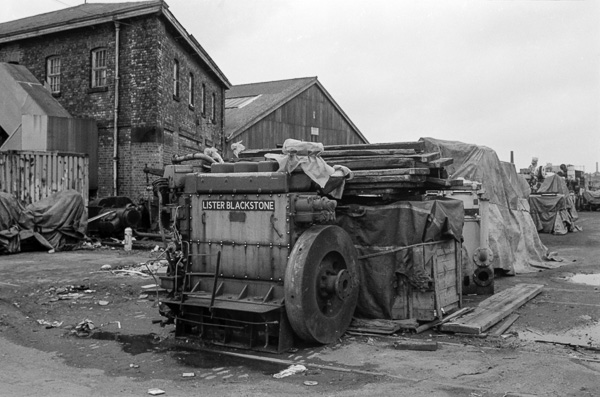
32p42: Victoria Dock, 1982 – Docks
28th April 2017
This view looks roughly east from close to the boundary of Victoria Dock and the distant buildings are I think the sheds around the half-tide basin and dock with, between the first two buildings the two pylons carrying the docks name between them at the entrance. In the far distance towards the right, at the end of the line of telephone poles is Hull’s tidal barrier, and in front of it a chimney, which could be one of the few surviving features in the redeveloped area, the engine house of the slipway. The engine itself is now on display beside the Marina on Humber Dock St.
By the time I took this picture in 1982, Victoria Dock was already filled in, and this Attendant’s Office where drivers were instructed to report was boarded up and redundant.
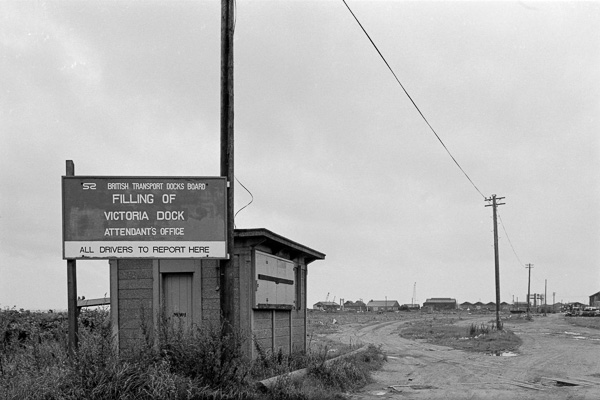
32p43: Attendant’s Office for Filling of Victoria Dock, 1982 – Docks
29th April 2017
There were still a few men working in what appeared to be a graveyard for boats at the east end of Victoria Dock, in an area which had once been part of Earle’s Shipbuilding & Engineering Yard.
Charles and William Earle set up in business together in 1845 as millwrights, founders and general smiths but realised the potential of iron hulled ships and in 1853 built their first vessel. After a disastrous fire in 1861 they moved to a 26 acre site to the east of the new Victoria Dock, later adding another 47 acres and were soon the second largest shipbuilder in England, close behind the Humber Ironworks and Shipbuilding Co (formerly Samuelson’s) based at Sammy’s Point. In the 19th century it built ships for the Chilean, Japanese, Russian and Greek navies – and eventually several cruisers for the Royal Navy, as well as cargo vessels, ferries and of course trawlers. The yard went bust in 1900 and after a year was bought by another Hull company, the the Wilson Line, then the largest private shipowners in the world (but bought in 1916 by Ellerman to become Ellerman’s Wilson Line.) The yard closed in 1932, with much of its equipment going to the Kowloon ship yard in Hong Kong.
The yard was one of the earliest to build steel ships and also pioneered the use of triple-expansion engines, but an earlier attempt at innovation with a cabin on gimbals to combat sea-sickness built for Henry Bessemer was a disaster. They built the Russian Imperial yacht and one of their final orders was a flat-pack steamer for use on Lake Titicaca which remained in service there for over 50 years. They had in 1904 built the SS Inca in similar kit form which was assembled at Lake Titicaca, 12,507 ft above sea level, in 1905.
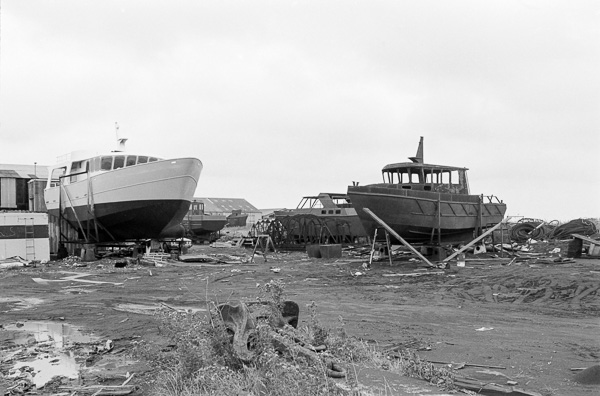
32p44 Site of Earle’s Shipbuilidng & Engineering works, Victoria Dock, 1982 – Docks
30th April 2017
Joynson & Son, Scale and Slicing machine specialists, established in 1892 were at 75 Mytongate, on the north side of the street in a row of shops between the Rampant Horse Inn and Thomas Borthwick and Sons Ltd, meat exporters on the corner of Vicar Lane. Joynsons are still in business, now at 45 Anlaby Rd, as catering equipment specialists, providing food service solutions & catering disposables.
The only building in this section of the street to escape demolition was the former Mytongate telephone exchange and headquarters of the Hull Corporation Telephone Department from 1914-64, at No.65 – though the street has since changed its name to Castle St, and is considerably wider, part of a continuing Highways Agency scheme to turn much of the city into the near-motorway A63, with a giant swathe of the Old Town lost to tarmac and wasteland, still largely awaiting recovery – or perhaps to be submerged by further road schemes.
Fly posters on the boarded up windows include those for ‘Rock Stateside’ at the Live Wire Disco, events at the City Hall and Hull Tower and a poster protesting against the first visit to Britain of President Reagan in June 1982 with the message ‘Neither Washington Nor Moscow But International Socialism’.
Hull demolition contractors D J Broady, ‘Space-Made’ went into administration in 2011. Together with Sam Allon they were responsible for demolishing many of Hull’s most notable buildings. The wife of one of Hull’s most prominent Aldermen was said to be a major shareholder in D J Broady.
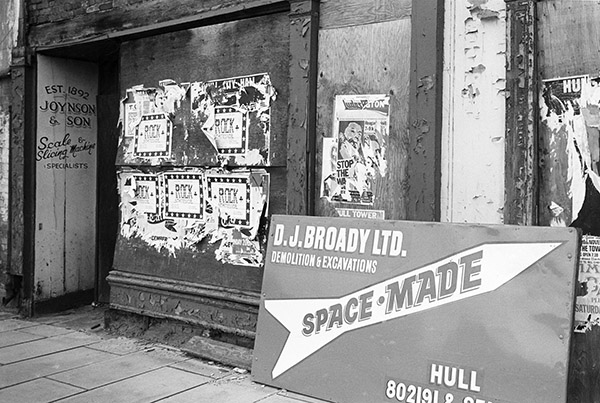
32p52: Joynson & Son, 75 Mytongate, 1982 – Old Town
1st May 2017
Telstar was I think TELSTAR CARAVANS LIMITED, a company who made caravans and whose registered office had the address Victoria Dock, Hull and went into liquidation in 1978-80. I’m not sure of its exact location in the dock but think it must have been to the west of the Half-Tide basin which I photographed a few frames later, and is fairly close to the bank of the Humber, perhaps near the slipway in what was once the LNER dock yard.
Probably the company was named after the 1962 instrumental hit written and produced by Joe Meek for the Tornados, which got it’s name from the first communications satellite to transmit TV across the Atlantic, Telstar 1, also launched in 1962.
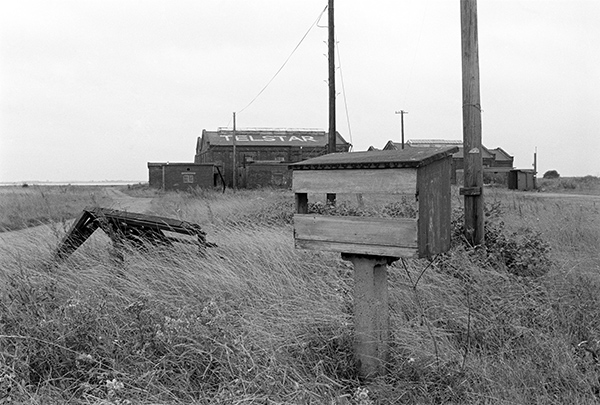
32p53: Telstar, Victoria Docks, 1982 – Docks
2nd May 2017
Burnett House was built as the Queen’s Hotel at 82 Mytongate, and in 1875 the frontage was rebuilt with the Britannia consoles and distinctive window surrounds and the hotel renamed as the Britannia Hotel. It closed as a hotel in 1913 and became the offices of shipping agents Stockwell & Co. Ltd. After the second war it was occupied by shipping agents Burnett & Co (Newcastle) Ltd and renamed Burnett House, though retaining the name Britannia Hotel on its east wall. It had been empty for some years when I took this picture stood empty and derelict for years on Mytongate.
Mytongate was around this time drastically widened as the A63 and renamed as Castle St, with Burnett House becoming 82-3 Castle St The frontage was finally renovated in 2006 back to its 1875 condition and advertised without success as office space. Later it was converted to seven flats and ground floor retail premises around 2015 when it was finally let. The ground floor is now occupied by an estate agents and property letting company. Some of the delay has been attributed to incompetence by the agency set up to market Hull Council properties, Hull Forward, which was disbanded in 2010.
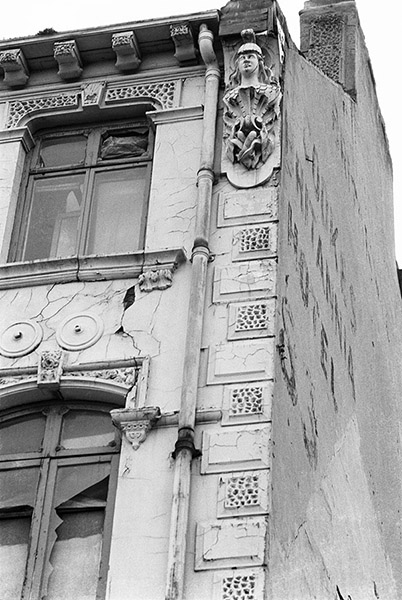
32p66: Burnett House, Mytongate (Castle St), 1982 – Old Town
3rd May 2017
These sheds were either along the dockside either close to the entrance lock to Albert Dock, and may have been taken from the south end of the substantial swing bridge which then took a roadway and the public footpath across the lock, or possibly on Humber Dock, where I made my next exposure.
There were warning lights and gates which closed the entrances to the bridge before it swung, and large notices prohibiting pedestrians or vehicles from being on the bridge while it was being operated. But on one occasion the bridge operators failed to notice that my wife was still walking across it with our younger son and took her for a ride.
The recent Scale St footbridge across the River Hull was designed and built as the first such footbridge in England that allowed foot passengers to be on it while it is operated, and is opened briefly every Saturday, at a time which depends on the tide for those who wish to take a short ride.
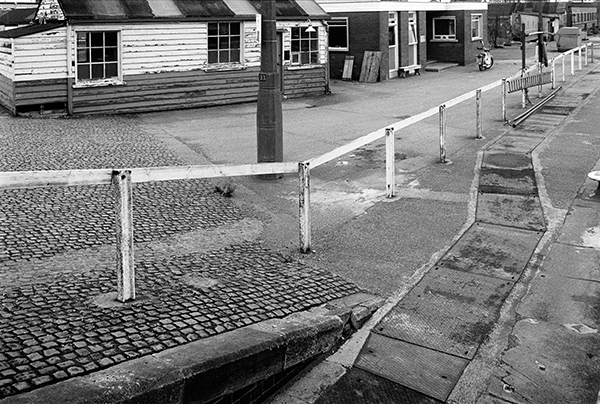
32q12: Dockside sheds, Albert Dock or Humber Dock, 1982 – Docks
You can see the new pictures added each day at Hull Photos, and I post them with the short comments above on Facebook.
Comments and corrections to captions are welcome here or on Facebook.
______________________________________________________
There are no adverts on this site and it receives no sponsorship, and I like to keep it that way. But it does take a considerable amount of my time and thought, and if you enjoy reading it, a small donation – perhaps the cost of a beer – would be appreciated.
My London Diary : Buildings of London : River Lea/Lee Valley : London’s Industrial Heritage
All photographs on this and my other sites, unless otherwise stated, are taken by and copyright of Peter Marshall, and are available for reproduction or can be bought as prints.